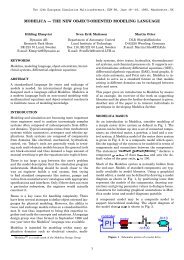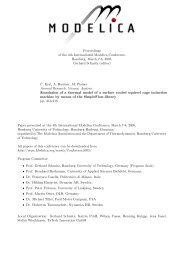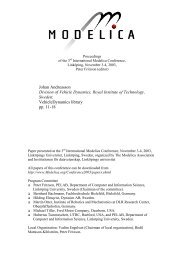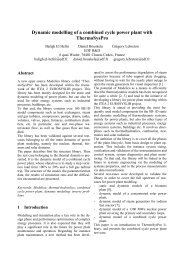Implementation of a Modelica Library
Implementation of a Modelica Library
Implementation of a Modelica Library
You also want an ePaper? Increase the reach of your titles
YUMPU automatically turns print PDFs into web optimized ePapers that Google loves.
2 Description <strong>of</strong> the use case retained<br />
The use case refers to the modeling and the simulation<br />
<strong>of</strong> two zero sequence wattmetric protections<br />
and a simplified MV compensated network. The protection<br />
is described in a specification paper established<br />
by EDF R&D. It has been developed to protect<br />
MV neutral compensated networks against mean<br />
and medium resistive single phase faults. This protection<br />
denoted PWH, is based on the analysis <strong>of</strong><br />
both transient and steady state values <strong>of</strong> residual current<br />
and residual voltage available in the compensated<br />
MV substation.<br />
Let’s briefly recall the principle <strong>of</strong> a compensated<br />
network and that <strong>of</strong> the PWH.<br />
In rural MV distribution networks, each feeder is<br />
mainly constituted <strong>of</strong> an overhead line and thus,<br />
when a fault occurs, the phase-to-ground capacitance<br />
current values are low (Figure 1). Therefore in these<br />
cases the neutral <strong>of</strong> the HV/MV transformer is<br />
grounded through a resistor and the fault current is<br />
equal to the neutral current.<br />
Figure 1 : Principles <strong>of</strong> compensated networks<br />
In mixed MV Distribution networks, an important<br />
part <strong>of</strong> each outgoing feeder is composed <strong>of</strong> underground<br />
cables. Therefore, contrary to the previous<br />
case, when a single fault occurs, the total capacitor<br />
current value seen at the MV busbar is important.<br />
Thus the resistor <strong>of</strong> the MV neutral grounding is replaced<br />
by a coil (a resistor in parallel with an inductor,<br />
refer to Figure 1) in order to compensate the zero<br />
sequence capacitor current and thus limit the current<br />
according to the international standard (insulation<br />
coordination). Consequently, if the mismatch <strong>of</strong> the<br />
coil is adjusted to zero Amps, the fault current is limited<br />
to the active neutral current part <strong>of</strong> the coil.<br />
Concerning the network modeling, a simplified<br />
MV compensated network is considered. The following<br />
assumptions are made :<br />
- The single phase fault is considered close to<br />
the MV busbar. Thus, the reactance <strong>of</strong> each<br />
outgoing feeder is neglected and only the<br />
phase-to-ground capacitance is considered,<br />
- The MV substation three phase voltage<br />
source is assumed to be balanced,<br />
- Consumption and reactive power compensators<br />
are not considered.<br />
Figure 2 : MV compensated network retained<br />
Therefore, the simplified MV network scheme retained<br />
is given in Figure 2. The substation is defined<br />
by its HV/MV transformer, its coil inserted on the<br />
neutral grounding and its MV busbar. One faulty<br />
feeder and two unfaulty feeders are considered. The<br />
second unfaulty feeder (without protection)<br />
represents an aggregation <strong>of</strong> all other unfaulty feeders.<br />
Two PWHs are also considered and respectively<br />
allocated to the faulty feeder and to the first unfaulty<br />
feeder (Figure 2). Its aim is to eliminate the single<br />
phase fault. To do that, the PWH has to send a trip to<br />
the circuit breaker <strong>of</strong> the faulty feeder.<br />
A PWH is based on the analysis <strong>of</strong> both transient<br />
and steady state values <strong>of</strong> residual current and residual<br />
voltage measured at the MV substation.<br />
PWH selective action is based on the known fact<br />
that the active component <strong>of</strong> the residual current in<br />
the faulty feeder is <strong>of</strong> the opposite direction and<br />
much greater than on any <strong>of</strong> the unfaulty feeders.<br />
Therefore, on the faulty feeder, the zero-sequence<br />
wattmetric relays detects negative zero sequence active<br />
power. On contrary, the protection placed on the<br />
unfaulty feeder detects a positive zero sequence active<br />
power.
















